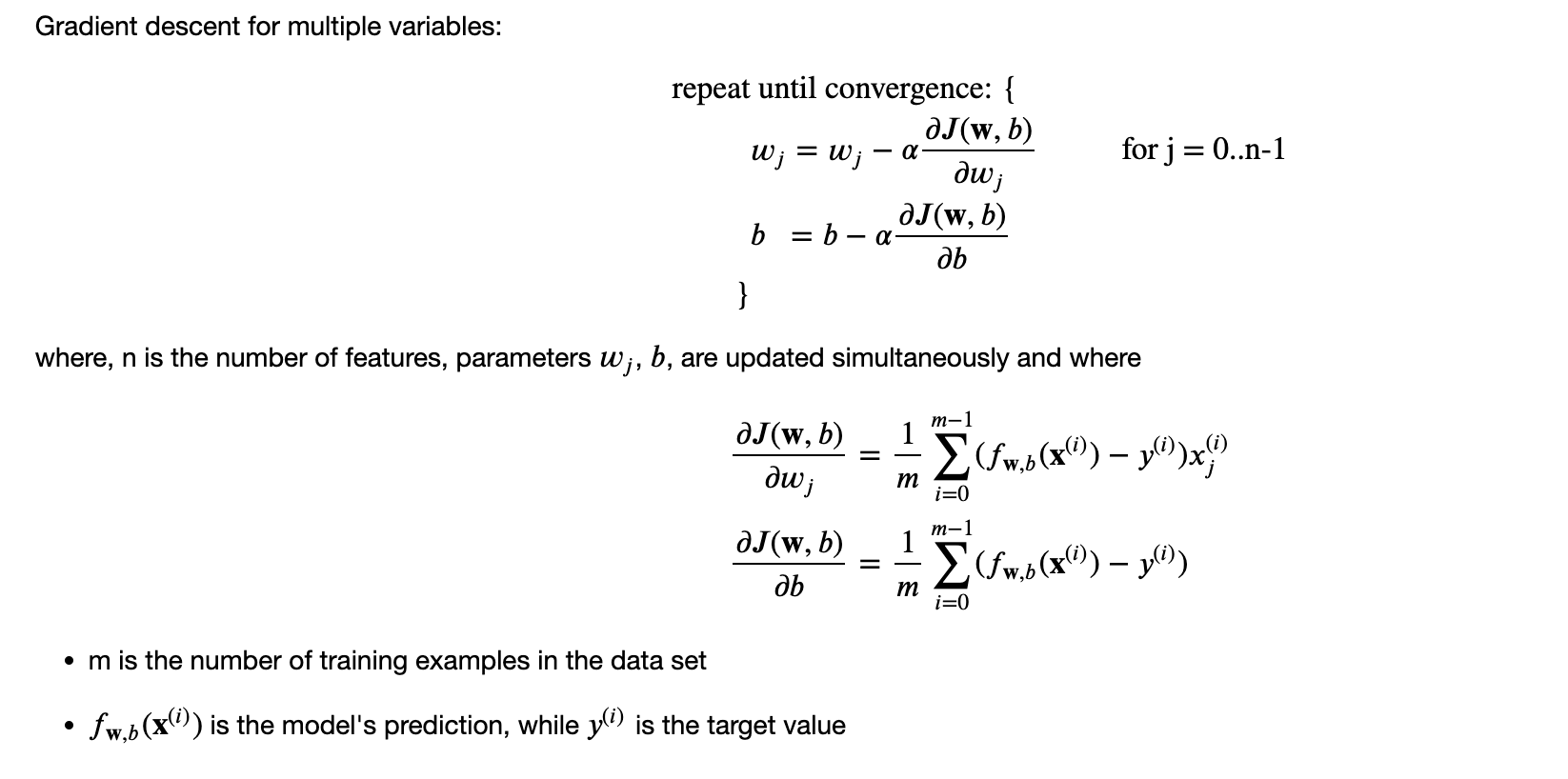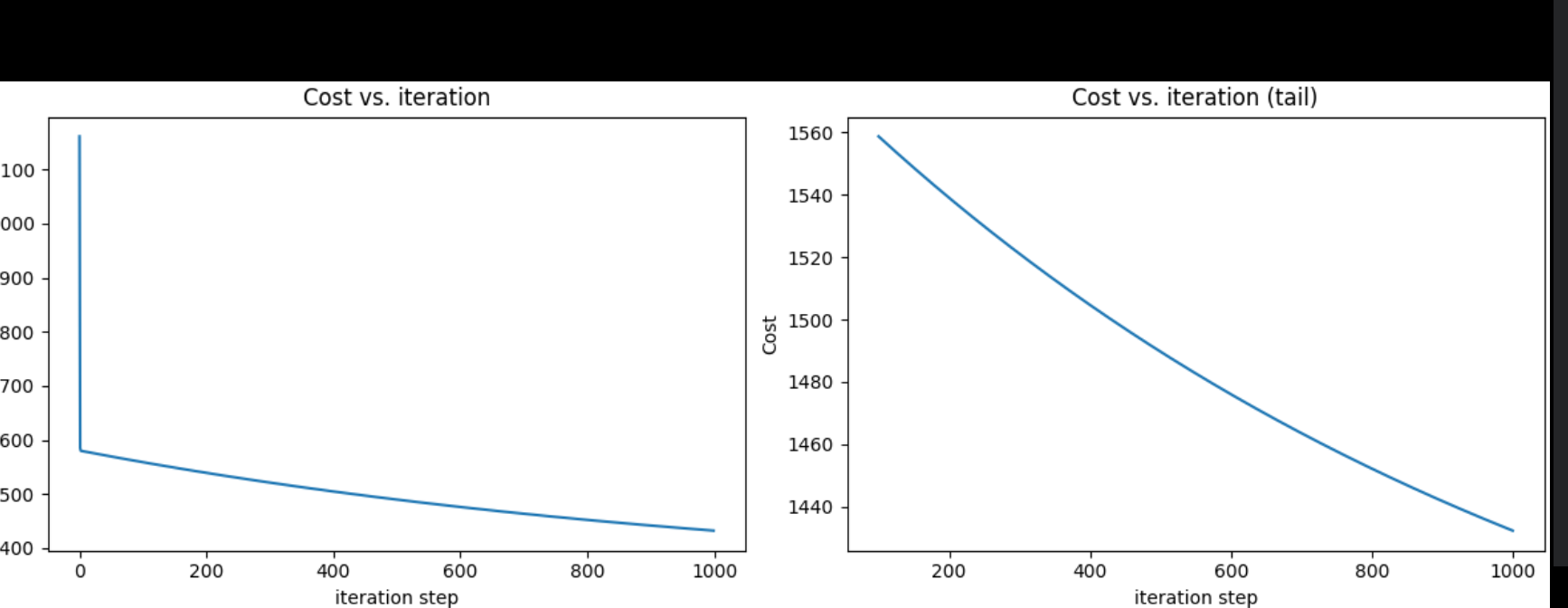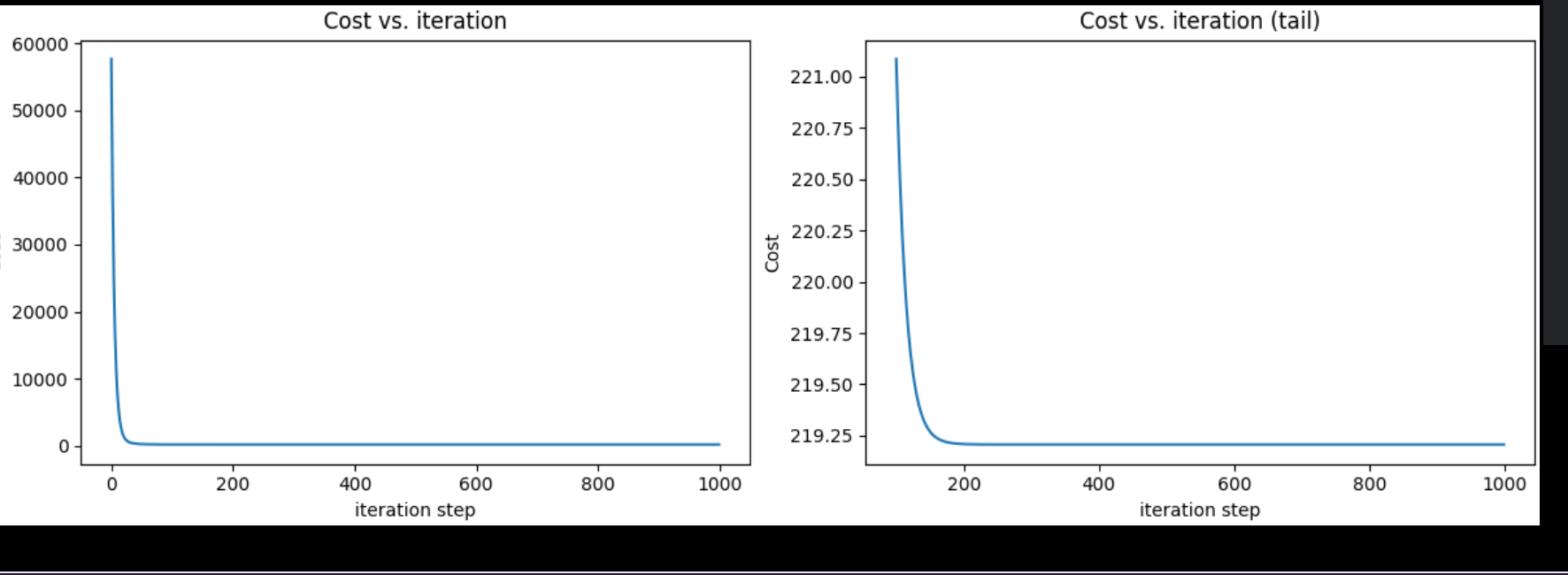1
2
3
4
5
6
7
8
9
10
11
12
13
14
15
16
17
18
19
20
21
22
23
24
25
26
27
28
29
30
31
32
33
34
35
36
37
38
39
40
41
42
43
44
45
46
47
48
49
50
51
52
53
54
55
56
57
58
59
60
61
62
63
64
65
66
67
68
69
70
71
72
73
74
75
76
77
78
79
80
81
82
83
84
85
86
87
88
89
90
91
92
93
94
95
96
97
98
99
100
101
102
103
104
105
106
107
108
109
110
111
112
113
114
115
116
117
118
119
120
121
122
123
124
125
126
127
128
129
130
131
132
133
134
135
136
137
138
139
140
141
142
143
144
145
146
147
148
149
150
151
152
153
154
155
156
157
158
159
160
161
162
163
164
165
166
167
168
169
170
171
172
173
174
175
176
177
178
179
180
181
182
183
184
185
186
187
188
189
190
191
192
193
194
195
196
197
198
199
200
201
202
203
204
205
206
207
208
209
210
211
212
213
214
215
216
217
218
219
220
221
222
223
224
225
226
227
228
229
230
231
232
233
234
235
236
237
238
239
240
241
242
243
244
245
246
247
248
249
250
251
|
"""
多变量回归预测房价
训练样本在house.txt中,包含特征:size(sqrt)','bedrooms','floors','age'和'price'
"""
import math
import copy
import numpy as np
import matplotlib.pyplot as plt
np.set_printoptions(precision=2)
#
# def cat_data():
# print("x:")
# print(x_train.ndim)
# print(type(x_train))
# print(x_train.shape)
# print("y:")
# print(y_train.ndim)
# print(type(y_train))
# print(y_train.shape)
def compute_cost(X, y, w, b):
"""
compute cost
Args:
X (ndarray (m,n)): Data, m examples with n features
y (ndarray (m,)) : target values
w (ndarray (n,)) : model parameters
b (scalar) : model parameter
Returns:
cost (scalar): cost
"""
m = X.shape[0]
cost = 0.0
for i in range(m):
f_wb_i = np.dot(X[i], w) + b # (n,)(n,) = scalar (see np.dot)
cost = cost + (f_wb_i - y[i]) ** 2 # scalar
cost = cost / (2 * m) # scalar
return cost
def compute_gradient(X, y, w, b):
"""
Computes the gradient for linear regression
Args:
X (ndarray (m,n)): Data, m examples with n features
y (ndarray (m,)) : target values
w (ndarray (n,)) : model parameters
b (scalar) : model parameter
Returns:
dj_dw (ndarray (n,)): The gradient of the cost w.r.t. the parameters w.
dj_db (scalar): The gradient of the cost w.r.t. the parameter b.
"""
m, n = X.shape # (number of examples, number of features)
dj_dw = np.zeros((n,))
dj_db = 0.
for i in range(m):
err = (np.dot(X[i], w) + b) - y[i]
for j in range(n):
dj_dw[j] = dj_dw[j] + err * X[i, j]
dj_db = dj_db + err
dj_dw = dj_dw / m
dj_db = dj_db / m
return dj_db, dj_dw
def gradient_descent(X, y, w_in, b_in, cost_function, gradient_function, alpha, num_iters):
"""
Performs batch gradient descent to learn theta. Updates theta by taking
num_iters gradient steps with learning rate alpha
Args:
X (ndarray (m,n)) : Data, m examples with n features
y (ndarray (m,)) : target values
w_in (ndarray (n,)) : initial model parameters
b_in (scalar) : initial model parameter
cost_function : function to compute cost
gradient_function : function to compute the gradient
alpha (float) : Learning rate
num_iters (int) : number of iterations to run gradient descent
Returns:
w (ndarray (n,)) : Updated values of parameters
b (scalar) : Updated value of parameter
"""
# An array to store cost J and w's at each iteration primarily for graphing later
J_history = []
w = copy.deepcopy(w_in) # avoid modifying global w within function
b = b_in
for i in range(num_iters):
# Calculate the gradient and update the parameters
dj_db, dj_dw = gradient_function(X, y, w, b) ##None
# Update Parameters using w, b, alpha and gradient
w = w - alpha * dj_dw ##None
b = b - alpha * dj_db ##None
# Save cost J at each iteration
if i < 100000: # prevent resource exhaustion
J_history.append(cost_function(X, y, w, b))
# Print cost every at intervals 10 times or as many iterations if < 10
if i % math.ceil(num_iters / 10) == 0:
print(f"Iteration {i:4d}: Cost {J_history[-1]:8.2f} ")
return w, b, J_history # return final w,b and J history for graphing
def zscore_normalize_features(X):
"""
这里使用z-score进行特征缩放
computes X, zcore normalized by column
Args:
X (ndarray): Shape (m,n) input data, m examples, n features
Returns:
X_norm (ndarray): Shape (m,n) input normalized by column
mu (ndarray): Shape (n,) mean of each feature
sigma (ndarray): Shape (n,) standard deviation of each feature
"""
# find the mean of each column/feature
mu = np.mean(X, axis=0) # mu will have shape (n,)
# find the standard deviation of each column/feature
sigma = np.std(X, axis=0) # sigma will have shape (n,)
# element-wise, subtract mu for that column from each example, divide by std for that column
X_norm = (X - mu) / sigma
return (X_norm, mu, sigma)
if __name__ == '__main__':
# 加载数据
data = np.loadtxt("./data/houses.txt", delimiter=',', skiprows=1)
X_train, y_train = data[:, :4], data[:, 4]
# X_train = np.array([[2104, 5, 1, 45], [1416, 3, 2, 40], [852, 2, 1, 35]])
# y_train = np.array([460, 232, 178])
x_features = ['size(sqft)', 'bedrooms', 'floors', 'age']
# cat_data()
b_init = 785.1811367994083
w_init = np.array([0.39133535, 18.75376741, -53.36032453, -26.42131618])
# # Compute and display cost using our pre-chosen optimal parameters.
# cost = compute_cost(X_train, y_train, w_init, b_init)
# print(f'Cost at optimal w : {cost}')
# # Compute and display gradient
# tmp_dj_db, tmp_dj_dw = compute_gradient(X_train, y_train, w_init, b_init)
# print(f'dj_db at initial w,b: {tmp_dj_db}')
# print(f'dj_dw at initial w,b: \n {tmp_dj_dw}')
# initialize parameters
initial_w = np.zeros_like(w_init)
initial_b = 0.
# some gradient descent settings
iterations = 1000
# alpha = 1e-7
alpha = 9e-7
# run gradient descent
w_final, b_final, J_hist = gradient_descent(X_train, y_train, initial_w, initial_b,
compute_cost, compute_gradient,
alpha, iterations)
print(f"b,w found by gradient descent: {b_final:0.2f},{w_final} ")
m, _ = X_train.shape
for i in range(m):
print(f"prediction: {np.dot(X_train[i], w_final) + b_final:0.2f}, target value: {y_train[i]}")
# plot cost versus iteration
# fig, (ax1, ax2) = plt.subplots(1, 2, constrained_layout=True, figsize=(12, 4))
# ax1.plot(J_hist)
# ax2.plot(100 + np.arange(len(J_hist[100:])), J_hist[100:])
# ax1.set_title("Cost vs. iteration")
# ax2.set_title("Cost vs. iteration (tail)")
# ax1.set_ylabel('Cost')
# ax2.set_ylabel('Cost')
# ax1.set_xlabel('iteration step')
# ax2.set_xlabel('iteration step')
# plt.show()
# m = X_train.shape[0]
# yp = np.zeros(m)
# for i in range(m):
# # print(f"prediction: {np.dot(X_train[i], w_final) + b_final:0.2f}, target value: {y_train[i]}")
# yp[i] = np.dot(X_train[i], w_final) + b_final
# # # plot predictions and targets versus original features
# fig, ax = plt.subplots(1, 4, figsize=(12, 3), sharey=True)
# for i in range(len(ax)):
# ax[i].scatter(X_train[:, i], y_train, label='target')
# ax[i].set_xlabel(x_features[i])
# ax[i].scatter(X_train[:, i], yp, color="#FF9300", label='predict')
# ax[0].set_ylabel("Price")
# ax[0].legend()
# fig.suptitle("target versus prediction using z-score normalized model")
# plt.show()
mu = np.mean(X_train,axis=0)
sigma = np.std(X_train,axis=0)
X_mean = (X_train - mu)X_sigma
# X_norm = (X_train - mu)/sigma
X_norm, X_mu, = zscore_normalize_features(X_train)
w_norm, b_norm, hist = gradient_descent(X_norm, y_train, initial_w, initial_b, cost_function=compute_cost, gradient_function=compute_gradient,alpha=1.0e-1, num_iters=1000)
# predict target using normalized features
m = X_norm.shape[0]
yp = np.zeros(m)
for i in range(m):
yp[i] = np.dot(X_norm[i], w_norm) + b_norm
# plot predictions and targets versus original features
fig, ax = plt.subplots(1, 4, figsize=(12, 3), sharey=True)
for i in range(len(ax)):
ax[i].scatter(X_train[:, i], y_train, label='target')
ax[i].set_xlabel(x_features[i])
ax[i].scatter(X_train[:, i], yp, color="#FF9300", label='predict')
ax[0].set_ylabel("Price")
ax[0].legend()
fig.suptitle("target versus prediction using z-score normalized model")
plt.show()
# plot cost versus iteration
fig, (ax1, ax2) = plt.subplots(1, 2, constrained_layout=True, figsize=(12, 4))
ax1.plot(hist)
ax2.plot(100 + np.arange(len(hist[100:])), hist[100:])
ax1.set_title("Cost vs. iteration")
ax2.set_title("Cost vs. iteration (tail)")
ax1.set_ylabel('Cost')
ax2.set_ylabel('Cost')
ax1.set_xlabel('iteration step')
ax2.set_xlabel('iteration step')
plt.show()
#
#
|








